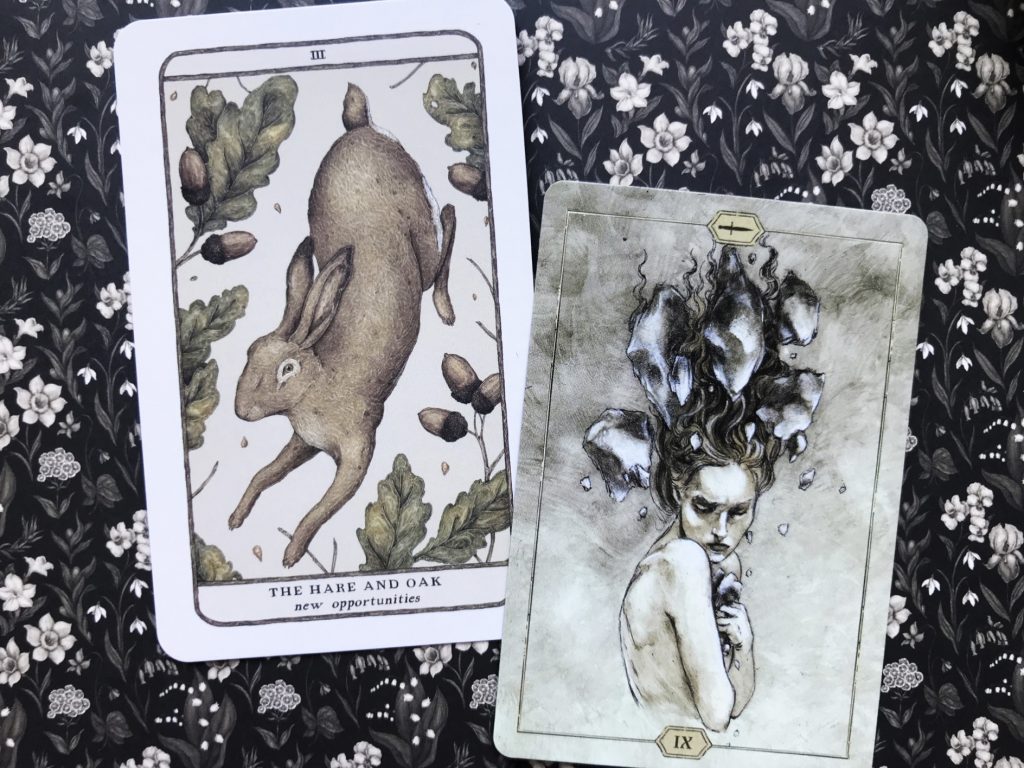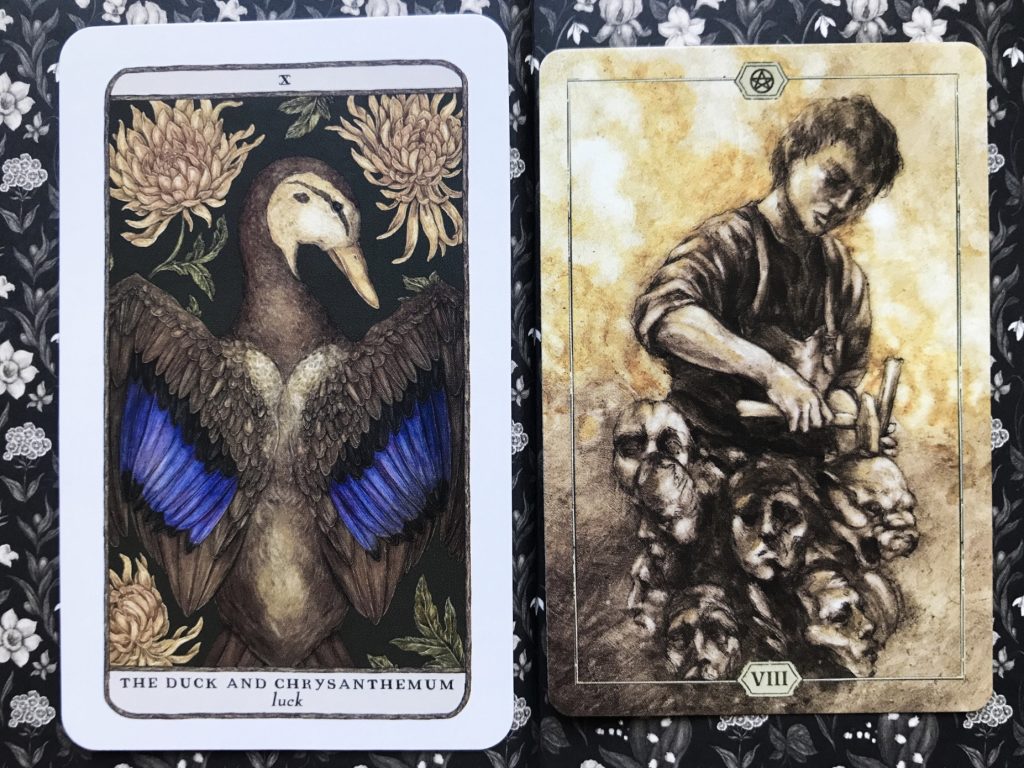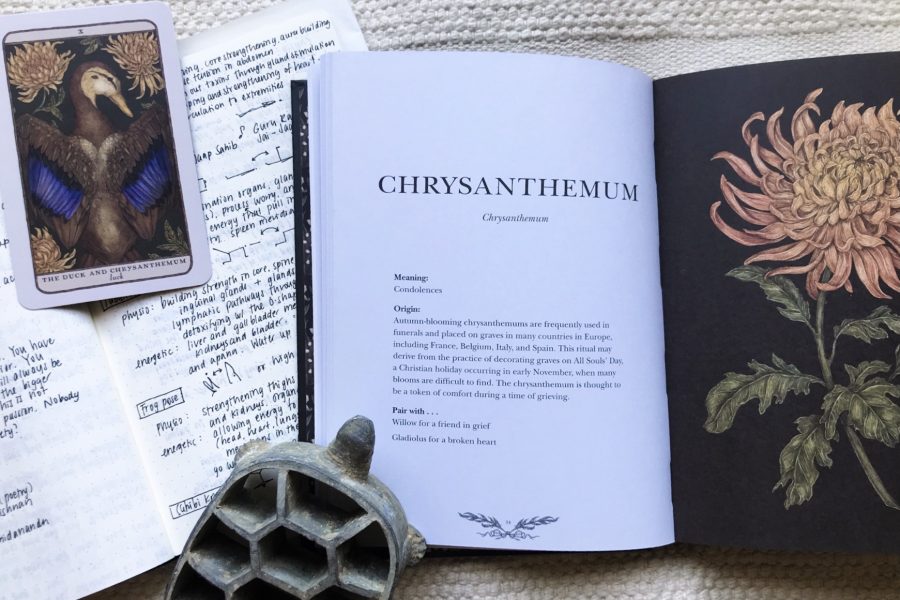If you’ve been practising yoga for some time and also have a good grasp of tarot, here’s something fun: create your own yoga rituals using tarot & oracle cards. I do this occasionally when I’m crafting a new yoga sequence, or just want to shake up old ideas and interpretations. This is a creative and playful way to have your yoga practice speak to you directly and be relevant in the story of your life. Below I share my design process using three example readings.
The two decks that I chose for this exercise are the Hush Tarot and the Woodland Wardens. I like the expansiveness of this specific oracle and how it converses with the tarot. Both decks also speak beautifully to the Autumn season. Once I’ve decided on the decks, I follow with a question/reading: I’m ready to start something new and have been experiencing a surge of energy since Mabon (my personal new year). I immediately feel deflated when things don’t go my way. What I need is a yoga ritual that can help me keep the momentum going. What can I do?
I already have some possible breathing techniques and poses in mind that can increase energy levels, like breath of fire, spinal flexes and twists, sun salutations, bhastrika with o-shape mouth.. but I’m also using the cards to bring more nuance and depth to this yoga ritual.

Reading #1
What comes to me immediately upon seeing these two cards together: When I’m eagerly anticipating something, I often get ahead of myself by imagining it already happening in full details. Sometimes I will have lived the entire story in reverie. But when I finally return to reality, I feel discouraged because I realise that things are not moving as I want them to.
Relevant passages from the guidebooks…
The Quail & Gooseberry: Fresh gooseberries are a tempting treat, but pick them without care, and you might hurt yourself.
Two of Wands: You have the energy but you are not sure where to direct it.
Thoughts after reading through the guidebooks: If my yoga ritual has a lot of strong poses or breath work, I will run out of steam pretty fast. That would be the complete opposite of my goal. I also need to contain my energy, rather than letting it disperse wastefully.
I know that for me, mantra is one really good way to focus my attention. And since I wish to keep the energy moving, I think a faster-paced mantra would be suitable in this case. Here, I might create a very short yoga ritual in two parts: chanting a short mantra a few times daily & resorting to 3-min of breath of fire whenever I feel my momentum dropping. Both of these are activating, but sustainable.
Pro-tip: When it comes to creating a yoga sequence, it’s always possible to select a pre-existing one from a book or a class you enjoy. (For example, I can think of at least two kriyas from the kundalini repertoire that would fit this situation perfectly.) I especially recommend this if you’re newer to yoga sequencing and don’t know where to start. But if you just want to play and don’t care for pedantic rules regarding anatomy & movement, go for it! You will know if it works once you step on the mat. Here’s your permission slip to make mistakes and start over.
Reading #2
Initial interpretation: It’s easy for me to self-sabotage with negative thinking when I’m seeking new opportunities. I’m quick to doubt or downplay my knowledge/abilities, or I become overwhelmed by unnecessary worry and don’t take action. When I lose momentum, I quickly sink into lethargy.

Relevant passages from the guidebooks…
The Hare & Oak: A variety of ancient cultures have linked the oak tree with bravery and vitality.
Nine of Swords: Fear and anxiety hang over our heads as a heavy burden. Realise these troubles are within us and not of the external world.
Following thoughts: How can I address the question of fear in my yoga ritual, if I desire to feel empowered, courageous, and fearless at the end of practice?
Based on this, I would create a 15-min class for myself that would include powerful warrior poses. It could begin with Surya Namaskar in variation B to warm up the hips and the spine. Then we could dance between warrior 1, humble warrior, warrior 2, and exalted warrior. Some years ago, I attended a drop-in class that ended with 8 minutes of us reciting out loud “I have the power to change!” and found it invigorating. I might include an affirmation at the end of a warrior sequence and finish with some standing forward folds.

Reading #3
First impressions: I can commit to my yoga practice daily, and also offer it up to the great goddess. I don’t have control over the result, I’m only responsible for showing up. The rest is up to the universe. But I also know that I don’t have to do this alone, I can ask for assistance from other beings, human and otherwise.
Relevant passages from the guidebooks…
The Duck & Chrysanthemum: In ancient Egypt, ducks were associated with riches—especially gold—and frequently given as offerings to the gods.
Eight of Pentacles: You continue to push towards refinement of your goals. All the details are coming into focus.
Upon looking more closely at the Eight of Pentacles, I was reminded of this story (which I heard during a yin class): According to the ancient yogis, we are artists of the mind. While sculptors see the work of art in their mind’s eye from a full block of marble and chisel away the excess to reveal the beauty underneath, yogis on the other hand need to artfully chip away those unneeded parts of the mind to attain Yoga.
Part of keeping the momentum going when embarking on something new is to not fall into the traps of my samskara’s (aka my BS). For me, yin is what allows for a direct encounter with those deeply ingrained grooves. I find it profoundly uncomfortable to hold a pose for several minutes and let my thoughts run amok while also experiencing interesting sensations in the body. For this one, I would design a 10-min yin sequence consisting of 3 shapes held for 3 min each, with 1 min savasana: lying in prone with a rolled blanket underneath the belly (don’t do this right after eating), dragon pose on the left, and on the right. It sounds counterintuitive to what I’m looking for, doesn’t it? However, I do like that this has a grounding effect and anchors the energy back into the earth (when my energy is constantly high, I feel untethered). But it’s also possible that this yin practice doesn’t provide me with what I need, and that’s okay. It’s just a creative exercise based on a reading. I can pull new cards, or bring in other elements to enhance the sequence.
Final notes: I don’t design all my yoga rituals using tarot & oracle. Sometimes I speak to an experience that I’ve had or a situation I’d like to overcome. Other times, I begin with the yoga itself or compose some poetic lines. Unless you plan to teach your sequences to a group of people (in which case, you do need to consider safety and other factors), there are no guidelines to do this. Use what you already know and practice, and see where that takes you. Go wild, earth child!
🌖 ♉
Featured decks:
Hush Tarot (Jeremy Hush)
Woodland Wardens (Jessica Roux)
Featured book:
Roux, J. (2020). Floriography: An Illustrated Guide to the Victorian Language of Flowers (Volume 1). Andrews McMeel Publishing.
